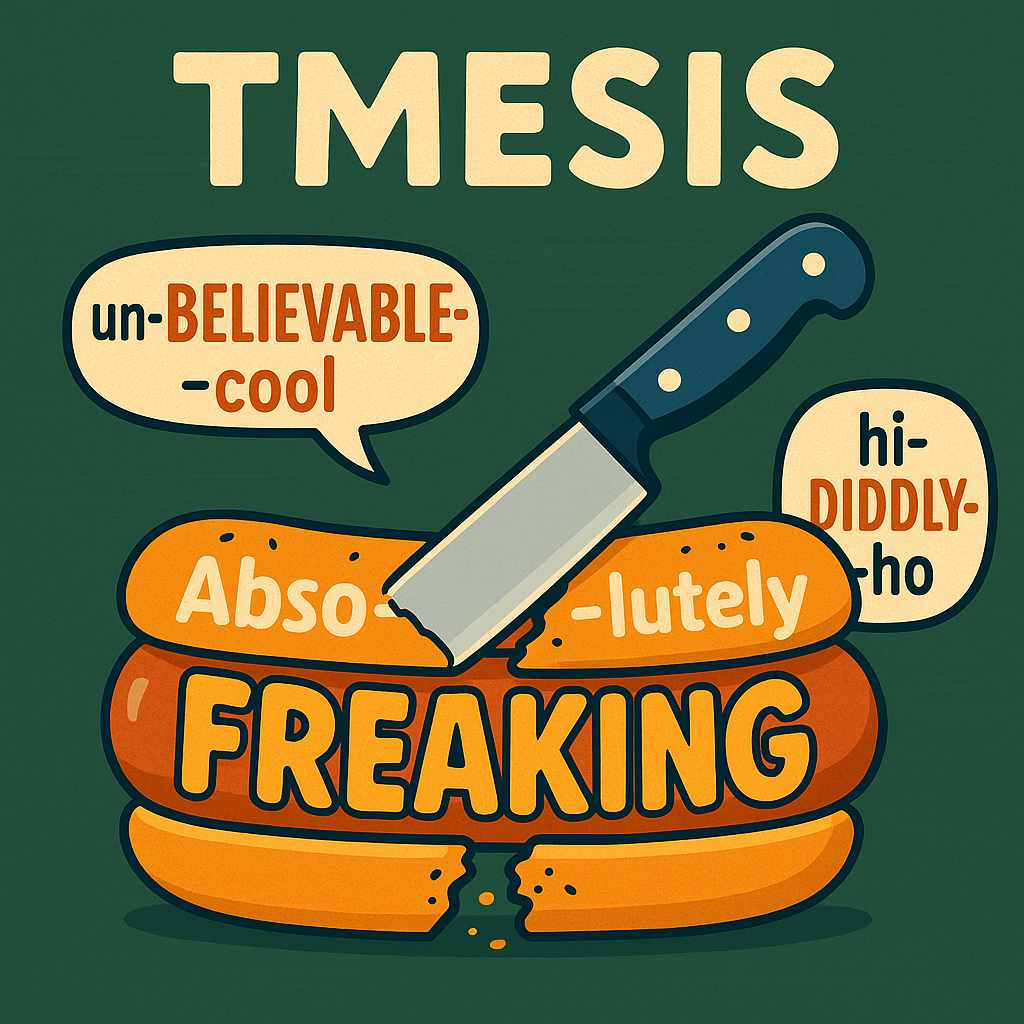Tmesis (pronounced tə-MEE-sis) comes from the Greek tmēsis, meaning “a cutting,” and refers to the insertion of a word (or more than one word) into another word or phrase to break it into two parts. Merriam‑Webster defines it as the “separation of parts of a compound word by the intervention of one or more words (e.g., what place soever for whatsoever place).”
Usage in Rhetoric and Wordplay
Tmesis serves as a rhetorical or stylistic device in literature, conversation, or public speaking. In formal terms, it’s grouped under rhetorical device or infixation. When used, it often leans on emphasis, humor, or colloquial flavor.
This technique is present in both cutting phrasal verbs—for example:
- “turn off” → “turn the radio off” (where “the radio” is inserted between verb and particle)
—and infixation, inserting an intensifier inside a word, e.g.:
- fan‑bloody‑tastic, abso‑freaking‑lutely
Literary Examples
One clear example of tmesis in a canonical work occurs in William Shakespeare’s Richard II. In Act 5, Scene 3, King Henry (Bolingbroke) says:
“If on the first, how heinous e’er it be,
To win thy after-love I pardon thee.”
Here, Shakespeare splits the word “howe’er” (a contraction of “however”) by inserting the adjective “heinous.” This interruption of the compound word creates emphasis—a textbook demonstration of tmesis in a classic play in verse.
Shakespeare’s Other Works
- Romeo and Juliet: “This is not Romeo, he’s some other where.” Splitting “somewhere” with “other” highlights the emotional distance Juliet feels.
- Troilus and Cressida: “A strange fellow here writes me that man–how dearly ever parted.” Here “however” is interrupted by “dearly,” creating a marked rhythmic break that draws attention to the inserted word.
John Donne — Hymn to Christ
Another clear-cut case of tmesis appears in the 17th-century poet John Donne’s work. In “A Hymn to Christ, at the Author’s Last Going into Germany,” Donne writes:
“In what torn ship soever I embark,
That ship shall be my emblem of thy ark.”
In this line, Donne splits the compound “whatsoever” by inserting the words “torn ship” in the middle. The result is “what torn ship soever,” which vividly illustrates tmesis by breaking a single word for poetic effect.
More Examples of Tmesis in Literature
- John Milton, Samson Agonistes (1671): “Harder to hit, (Which way soever men refer it), much like thy riddle, Samson, in one day…” (splitting “whichsoever” into “which way soever”).
- Jane Austen, Sense and Sensibility (1811): “…she could live with him upon a trifle, how little so ever he might have, she should be very glad to have it all, you know…” (splitting “howsoever” into “how little so ever”).
- Charles Dickens, Great Expectations (1861): “Howsomever, I’m a getting low, and I know what’s due.” (dialectal splitting of “however” into “how some ever”).
- Robert Louis Stevenson, Treasure Island (1883): “Howsomever, sperrits don’t reckon for much, by what I’ve seen. I’ll chance it with the sperrits, Jim.” (splitting “however” into the colloquial “how-some-ever”).
These quotations insert one or more words into a compound term or fixed phrase. Each demonstrates the classic tmetic insertion (e.g., “so ever” or “some” breaking up an otherwise continuous word) for emphasis or stylistic effect.
Linguistic Roots and Historical Context
Ancient Greek’s early poetry, especially Homer, often separates pre‑verbs from verbs, like kata dakrua leibōn (“shedding tears”), rather than using the combined form kataleibōn.
In Latin poetry, tmesis serves a visual or rhetorical purpose. For instance, circum virum dant (“they surround the man”) separates circumdant (surround) for effect. Another example: in Ennius, saxo cere comminuit brum (“he shattered his brain with a rock”) splits cerebrum to intensify imagery.
Further Reading
Tmesis on Wikipedia




